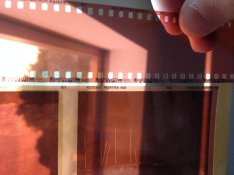Jessestr
Member
- Joined
- Mar 31, 2014
- Messages
- 399
- Format
- 35mm
Well I got to admit.. C-41 is little harder than I thought but it's going okay. Never had any issues doing black and white..
So I used a Jobo CPE2 with Digibase kit to develop some rolls. Develops are olay but they have a slightly other kind of tint and when scanned they get a little to green. Feels like there is missing something.
It's not a color shift but more a color cast.
Here's a picture of Portra 400 (both) (bottom one I what I developed myself, top one is what the lab developed, just a clear negative) You can see clearly that it has a different color. On my lab negatives you can see the different color layers very well. Looks like mine don't have. However when I scan them with all the color cast corrections it's okay.. but still not like how it should be.
Any ideas what could be wrong? Need to master this
So I used a Jobo CPE2 with Digibase kit to develop some rolls. Develops are olay but they have a slightly other kind of tint and when scanned they get a little to green. Feels like there is missing something.
It's not a color shift but more a color cast.
Here's a picture of Portra 400 (both) (bottom one I what I developed myself, top one is what the lab developed, just a clear negative) You can see clearly that it has a different color. On my lab negatives you can see the different color layers very well. Looks like mine don't have. However when I scan them with all the color cast corrections it's okay.. but still not like how it should be.
Any ideas what could be wrong? Need to master this












